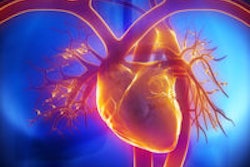
The broader use of nuclear myocardial perfusion imaging (MPI) stress tests could help emergency department (ED) physicians better determine which patients can be safely discharged after a normal electrocardiogram and negative biomarker (troponin) results, according to a February 1 talk at the Canadian Association of Nuclear Medicine (CANM) meeting in Montreal.
"I would argue we should do more [stress MPI exams]," said Dr. Bruce Eagleson, associate chief of staff at the Lebanon Veterans Affairs Medical Center in Lebanon, PA.
In an interview with AuntMinnie.com, Eagleson said more frequent use of stress MPI exams would likely prevent the discharge of patients who might otherwise go on to have an acute cardiac event.
"There are cases with the current system [of tests] that we can't detect," he said. "Is there a third piece of information to differentiate between those who are safe to go home and those who aren't? Nuclear medicine may have that test."
Sensitivity is a priority to ED physicians, not specificity, Eagleson pointed out.
"We would rather admit patients who didn't need to be admitted than send them home and have them do badly," he said, adding that ED physicians want to be able to rule out heart disease or the threat of myocardial infarction (MI) with confidence.
Prior testing, such as a negative stress test or a negative cardiac catheterization in the last month, does not necessarily rule out coronary artery disease or that the patient has an increased risk for a cardiac event in the future. But stress MPI testing before patient discharge can help rule out coronary artery disease in the short term.
"There are very good data to support that if they ... pass a stress test, they will be stable for the next couple of weeks," Eagleson said. "They will be stable until they see their primary physician and figure out the next steps."
Eagleson identified barriers to providing more stress MPI examinations to ED patients suspected of having coronary artery disease, including the availability of isotopes, as well as the availability of nuclear medicine physicians and technicians.
He did not suggest that nuclear medicine physicians be available 24/7 for the purposes of conducting stress tests; however, undergoing stress MPI within the first 72 hours of presenting to the ED would likely improve the identification of patients at risk of a cardiac event, and this could be achieved with some flexibility in staff scheduling, he said. He added that there may be reluctance to order supplementary isotopes because they do not have long shelf lives.
"This is an issue of culture change," Eagleson said.
Chest pain is the most common symptom of coronary artery disease; other symptoms of heart disease and/or myocardial infarction include shortness of breath, nausea, light-headedness, and pain in the arms, back, jaw, and upper stomach. However, patients who present to the ER may also complain of uncommon symptoms such as left elbow pain or a sore throat, Eagleson said.
A notable number of patients come to the ER with heart disease and may go on to have an acute MI, yet they do not initially experience chest pain, he added.
"Anywhere from 50% to 80% have chest pain," he said. "That means 20% [of patients who present] with heart disease, and maybe an acute MI, are not having chest pain."
One study cited that 5.4% of all ED visits at U.S. hospitals are based on complaints of chest pain; with there being 120 million ED visits annually in the U.S., this works out to 6.5 million cases of chest pain presentation. However, Eagleson emphasized that not all of those patients should undergo stress MPI tests. One emerging test that could be used as an alternative is a high-sensitivity troponin assay.


















